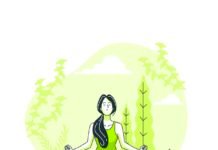The current study aims at finding the resilience, and death anxiety among Indian and foreigners during Covid 19 pandemic. The sampling method used in this study is convenient sampling. The respondents of the study are 112 people which includes 77 respondents from India and 35 respondents from other countries. The tools used in the data collection of the research are Brief Resilience scale by Smith, B.W., Dalen, J., Wiggins, K, Tooley, E., Christopher, P, & Bermard, J (2008) , and death anxiety scale by Conte, H. R., Weiner, M. B., and Plutchik, R. (1982). The data collected were analysed through independent sample t-test. The results indicate that there is no significant difference in resilience and death anxiety between Indian and foreigners. The study also indicated that there is no significant difference in males and females.
“The ability to withstand adverse events and stressful situations without falling apart, by actively and positively coping with stress” (Stein and Book).
“The process of adapting well in the face of adversity, trauma, tragedy, threats or even significant sources of stress.” (American Psychological Association, 2014).
Commonly used terms, which are closely related within psychology are psychological Resilience, Emotional Resilience, Hardiness, Resourcefulness and mental toughness. Several factors are found to modify the negative effects of adverse life situations. Many studies show that the primary factor is to have relationships that provide care and support, create love and trust, and offer encouragement, both within and outside the family. Werner (1995) distinguished three contexts for protective factors.
- Personal attributes including outgoing, bright, and positive self-concepts;
- The family, such a shaving close bond with at least one family member or an emotionally stable parent;
- The community, like receiving support or counsel from peers.
Resiliency is not mere passive resistance against injury or threatening condition, Freiburg, Hjmdal Zuznyng, Martinson (2005), in their theoretical paper proposed three-fold classification of resiliency:
- Mood features include: Personal Competence, social competence and private structures.
- Family cohesion or intimacy include: family correlation or rate of conflicts, cooperation, support, stability, loyalty in the family.
- The external support networks of friends, affiliates and the protector is being.
A recent study identified the core factors that appear to be associated in the development and strength of an individual’s psychological resilience. This five-part model found a relationship between an individual’s cognitions, emotions, behaviours and physical activates within the environment (De Terte, et al., 2009). Within the environment, the factors that can influence this variables affect were found to be family support, community support and societal support.
Factors in Resilience
A combination of factors contributes to resilience. Many studies show that the primary factor in resilience is having caring and supportive relationships within and outside the family. Relationships that create love and trust provide role models and offer encouragement and reassurance help bolster a person’s resilience. Several additional factors are associated with resilience, including:
- The capacity to make realistic plans and take steps to carry them out.
- A positive view of yourself and confidence in your strengths and abilities.
- Skills in communication and problem solving.
- The capacity to manage strong feelings and impulses.
All of these are factors that people can develop in them. Some or many of the ways to build resilience in the following pages may be appropriate to consider in developing your personal strategy.
Building Resilience
In cognitive behavioural therapy, building resilience is a matter of mindfully changing basic behaviours and thought patterns. The first step is to change the nature of self-talk. Self-talk is the internal monologue people have that reinforce beliefs about the person’s self-efficacy and self-value. To build resilience, the person needs to eliminate negative self-talk, such as “I can’t do this” and “I can’t handle this”, and to replace it with positive self-talk, such as “I can do this” and “I can handle this”. This small change in thought patterns helps to reduce psychological stress when a person is faced with a difficult challenge. The second step a person can take to build resilience is to be prepared for challenges, crises, and emergencies.
Resilience is also enhanced by developing effective coping skills for stress. Coping skills help the individual to reduce stress levels, so they remain functional. Coping skills include using meditation, exercise, socialization, and self-care practices to maintain a healthy level of stress, but there are many other lists associated with psychological resilience.
Developing resilience is a personal journey. People do not react all the same to traumatic and stressful life events. An approach to building resilience that works for one person might not work for another. People use varying strategies.
Some variation may reflect cultural differences. A person’s culture might have an impact on how he or she communicates feelings and deals with adversity — for example, whether and how a person connects with significant others, including extended family members and community resources. With growing cultural diversity, the public has greater access to a number of different approaches to building resilience. The other ways in which one can enhance their resilience are as follows
1. Visualize success
Resilient people create their own vision of success. This helps them achieve their goals by providing a Clear sense of where they’re headed. Your vision needs to be rounded and vibrant and based on what is currently possible; resilient people don’t waste time on impossible dreams or hankering after things they will never have. They recognize the fine line between stretching goals and unrealistic goals.
2. Boost your self-esteem
Some people are naturally blessed with high self-esteem. Others, need to work on self esteem, which involves understanding where it comes from and what makes them feel good about yourself. The checklist below may help.
• Identify what you’re good at. What can you feel positive about?
• Recognize what other people appreciate about you.
• Allow others to praise you, and resist the temptation to brush compliments aside.
• When something goes wrong try to avoid beating yourself up unnecessarily; understand that everything happens for a purpose.
• Don’t compare yourself with other people.
• When things go well for others feel genuinely pleased for them.
• Enjoy it when something goes better than you thought it would.
• Praise yourself
3. Take control
Resilient people believe they can make a difference and be successful. Others suffer from unhelpful beliefs, here are 6 of the most common:
- I am the victim of my personal history– Your past must have an impact, but is no excuse for not improving yourself now.
- There’s so much to do it’s not even worth trying– Life is complex, and you now have to do more with less. As a result, you may come to believe there are simply so many imperatives that you can’t see where to start. Psychologists call this ‘agglomeration’ – feeling overwhelmed by the volume and complexity of the issues. Break the problem down, establish priorities and take first things first.
- You only get one shot – Occasionally this may be the case, but not often, especially in circumstances where even the experts can’t predict the right way to go. It then becomes a question of trial and error, always being alert to the worst-case scenario and unintended consequences.
- There’s a right answer to everything– Analysts dream that by scrutinizing data hard enough, the ‘correct’ answer will emerge. This rarely happens in real life. The danger is that analysis becomes a substitute for, rather than a prelude to, action.
- I’m on my own– It’s easy to believe that you are the only one suffering and that you have to weather the storm alone. The old adage ‘a problem shares is a problem halved’ works well in these circumstances; talking things through is a source of strength, not a sign of weakness.
- This isn’t fair– Doctors claim that perpetrators of crimes heal more quickly than their victims. More generally, if you believe you have in some way contributed to a problem, you may feel more motivated to resolve it. If you are not to blame you tend to dwell on the unfairness of the situation rather than on what can be done. Recognize when your thinking is negative and immediately turn it around so that it becomes positive.
4. Become more optimistic
Optimism is one of the most important characteristics of resilient people; it is vitally important to look on the bright side, have confidence in your own abilities, and salvage what you can from problematic situations. Even those who lean towards the glass-half-empty mind-set can learn.
5. Manage stress
Psychologists see stress as an energizing force – up to a point, beyond which it becomes debilitating. Highly resilient people have a higher tipping point and, when things threaten to get them down, they know how to deal with it. Sources of stress are unique to you: to boost your resilience, you need to identify what your stressors are and how to counteract them. There are also personality traits that make some individuals more stress-prone. If you tend towards any of the following, discipline yourself to reduce or eliminate them displaying hostility, hiding feelings , being unable to listen properly, being over-perfectionist , having difficulty relaxing, being generally critical.
Stress management falls into 2 categories – distraction and resolution. Distraction techniques include exercise, breathing deeply, walking or extracting yourself from the situation. Resolution is focused on solving the problem.
6. Improve decision-making
Resilience requires you to make rather than avoid decisions. Resilient people trust their own judgement, but aren’t afraid to challenge their minds. They know that decisions are rarely irreversible and that procrastination is the enemy of resilience. Understanding your preferred decision-making approach is a critical step towards building resilience. Tips for shifting your style are given below.
7. Ask for help
You don’t have to do this alone; resilient people know when to reach out to others – and who is best to turn to. Do you have this strength of network? If not, map it out. Draw a circle on a sheet of paper – that is you. Draw your network, with others depicted as circles too: the more important they are to you, the larger the circle; the stronger the relationship, the closer they are to you. Draw lines linking you to others and others to one another, dotted lines for indirect relationships. Consider what you want from them and what you can offer and add this to the map.
8. Deal with conflict
Conflict occurs when our views differ from those of another person – so we have to deal with conflict every day. The ability to handle it constructively is an important part of resilience – ensuring that the style of resolution is appropriate, given the nature of the conflict and the other party. The ‘Conflict Resolution’ panel below gives examples and suggested tactics.
- Nature of problem and a Possible approach
- Although I’m annoyed, it’s a trivial matter this is one to let drop – get over it.
- My solution is better than the other person’s but their approach could work.
- It’s not worth fighting over. Win credit for your flexibility.
- This is important, something that requires a well-though-through solution. I have strong views but so does the other person.
9. Learn
Thinking regularly about what lessons can draw from your experience strengthens your ‘learning muscle’ and helps you build resilience. Figure out how you learn best and take the most from the experiences life throws at you.
10. Be yourself
You may be determined to enhance your resilience but you won’t succeed if your plan for doing this offends your core identity and values. The most resilient leaders are as self-aware as they are self-confident.
Getting help when you need it is crucial in building your resilience. Beyond caring family members and friends, people often find it helpful to turn to:
- Self-help and support groups. Such community groups can aid people struggling with hardships such as the death of a loved one. By sharing information, ideas and emotions, group participants can assist one another and find comfort in knowing that they are not alone in experiencing difficulty.
- Books and other publications by people who have successfully managed adverse situations such as surviving cancer. These stories can motivate readers to find a strategy that might work for them personally.
- Online resources. Information on the web can be a helpful source of ideas, though the quality of information varies among sources.
Indicators of resilience
- Use mind-calming and restorative activities.
- Continually undertake challenges to experience and learn new things.
- View future with optimism and hope.
- Emphasize positive (optimistic) thinking over negative (pessimistic) thinking
- Persist in pursuit of important goals.
- Choose actions consistent with deeply held values
- Experience a sense of purpose in life.
Principles of Resilience
- Everyone has the capacity for Resilience. It is not just for students from high risk populations.
- It is a process not a trait.
- Resilience is ordinary, not extraordinary
- Resilience is not a program or a curriculum. It requires that we shift from a “problem based deficit model to strengths based on model”. It is a part of our missions. It is a culture. It is an outcome.
- Challenges of all kinds are opportunities for growth and change: institutions, departments, services, faculty, staff and students.
Death anxiety
Definition
Death anxiety refers be fear and or anxiety related to the awareness, anticipation of death, nonexistence and dying. It typically includes emotional, cognitive and motivational components that vary according to a person’s stage of development and sociocultural experience (Lehto & stein, 2009).
TYPES OF DEATH ANXIETY:
- Predatory death anxiety:
Predatory death anxiety arises from the fear of being harmed. The most oldest and basic form of death anxiety. It originated from unicellular organisms. In human being it is evoked form dangers situations, it leads to fight or flight response – an internal mechanism to combat threatening situation
- Predation or predator death anxiety:
Predation or predator death anxiety arises when individual is harmed physically and or mentally by one another
- Existential death anxiety:
Existential death anxiety arises from the basic belief and knowledge that human life mast end at one point or another.
THEORIES:
Thanatophobia:
Thanatophobia is the fear of death as hypothesized by Sigmund Freud. According to Freud nobody believes in their death it is the unconscious unresolved conflict.
Ego integrity:
According to Eric Erickson stages of development, during the old age people seek ego integrity, where they try to look through their life if they could find the meaning of life they will reach the integrity stage suppose if the person didn’t find the meaning of his or her life they may not reach the integrity stage which in turn may cause death anxiety.
Terror Management Theory:
Terror management theory was proposed by Ernest Becker, he proposes that the death anxiety may generate fear and phobia about everyday life.
COVID 19
COVID 19 is a corona virus disease, first identified in Wuhan, china on 31 December 2019. The outbreak was declared on 30 January 2020 as a public health emergency of international concern. It is mainly transmitted through droplets by the infected person when they cough, sneeze. One can be affected with the virus when they maintain 0a proximity with the infected person or by touching the surface which are contaminated and when touching your eyes, nose or mouth. Due to the constant spread and outbreak of corona virus many countries including India is under lockdown. Lockdown is a prison protocol where the people or the information is prevented from leaving the area. Currently many countries announced a full lock down a full lockdown is usually where the people are advised to stay in their home or closest enclosed places in order to protect themselves and to stay safe. Many countries have implemented emergency lockdown to prevent the spread of the virus, to identify the infectious person and to ensure safety and security of the people, organization and system.
PREVENTION:
- Washing hands
- Social distancing
- Avoid touching nose, moth and eyes
- Cover mouth and nose while sneezing and coughing
- Stay home when unwell
- If you cough, fever and difficulty breathing seek medical attention.
- Follow the direction of your local health authority
Need for the study:
COVID 19 is a type of corona virus which is threating the world to a greater extend, due to which many countries are under lockdown. The current situation of pandemic COVID-19 is affecting the people economically, physically psychologically and socially. This study will help us understand the difference in the impact on death anxiety and resilience between male and female and also between Indians and foreigners.
METHODOLOGY
The methodology pertaining to study the “Influence on resilience and death anxiety during Covid 19 lockdown for Indians and foreigners” was carried out in the following steps:
Objective
- To find out the influence of Covid 19 lockdown on resilience between Indian and Foreigners.
- To find out the influence of Covid 19 lockdown on death anxiety between Indian and Foreigners.
- To find out the significant difference on resilience and death anxiety between Indians and Foreigners.
- To find out the influence of Covid 19 lockdown on resilience between male and female.
- To find out the influence of Covid 19 lockdown on death anxiety between male and female.
- To find out the significant difference on resilience and death anxiety between male and female.
Research question
The above mentioned objectives have been based on the following research questions.
- What is the level of influence of Covid 19 lockdown on resilience between Indians and Foreigners?
- What is the level of influence of Covid 19 lockdown on death anxiety between Indians and Foreigners?
- Whether there is any significant difference between Indians and foreigners on resilience and death anxiety?
- What is the level of influence of Covid 19 lockdown on resilience between male and female?
- What is the level of influence of Covid 19 lockdown on death anxiety between males and female?
- Whether there is any significant difference between male and female on resilience and death anxiety?
Hypothesis
- There is no significant difference in resilience between Indians and Foreigners.
- There is no significant difference in death anxiety between Indians and Foreigners.
- There is no significant difference in resilience between male and female
- There is no significant difference in death anxiety between male and female
Area
The study was carried out among the people around the world. The reason for choosing this area for the study is:
- Accessibility for the research.
- Because the population India and foreigners are under pandemic areas.
- The availability of the required participants for the study.
- The willingness and the cooperation of the participants to serve as subjects for the study.
Participants
In order to conduct the study, the data was collected from the people around the world. 112participants which consists of both male and female from India (N=77) and other countries (N=35). It includes 77 Indians and 35 Foreigners. The sampling method used in this study is purposive sampling.The inclusive criteria for the sample was the people in countries under Covid 19 pandemic lockdown.
Tools
The following tools were used for data collection:
- Brief resilience scale: It is a measure of resilience constructed by Smith,B.W., Dalen,J., Wiggins, K, Tooley, E., Christopher, P, & Bermard, J (2008)The scale consisted of 6 items with likert scale rating from 1(strongly disagree) to 5(strongly agree). Respondents were asked to answer each item by indicting the extent of their agreement to the given statements.
- Death anxiety scale: It is a measure death anxiety by Conte, H. R., Weiner, M. B., and Plutchik, R. (1982). The scale consist of 15 questions with likert scale rating of 0(not at all) to 2 (very much). Respondents were asked to tick the option that was appropriate to the current state.
Procedure
The participants were mailed with the forms, which consists of the brief resilience scale and death anxiety scale. The forms included a brief introduction about me and the research. And the following instructions, “The scale consists of 15 statements. Read each statement carefully and please indicate the choices that suits you the most by placing a tick mark”.
Analysis of data
The data was analysed using the SPSS software. The major statistical method used in this study involves “independent sample t-test”. The independent sample t-test was used to find out the influence of resilience and death anxiety among Indians and foreigner and to find the influence of death anxiety and resilience on male and female.
RESULT AND DISCUSSION
The study on “Influence on resilience and death anxiety during Covid 19 lockdown for Indians and foreigners” was conducted by collecting data by mailing the questionnaire. We had 112 participants which consists of both male and female from Indians and Foreigners by using purposive sampling method. The inclusive criteria is the people under lockdown. Brief resilience scale and death anxiety scale was the tool used for this study.
The results of the study are analysed, tabulated and discussed below.
| S. No | Variable | N | Percent | |
| Gender | Male Female | 25 87 | 22 78 | |
| locality | Indian Foreigner | 77 35 | 69 31 | |
| Education | Non Graduates Graduates | 20 92 | 18 82 | |
| Resilience | Low Moderate High | 26 82 4 | 23 73 4 | |
| Death anxiety | Low Moderate High | 62 6 44 | 55 5 40 |
Table I shows the percentage value for the demographic data of the study. The percentage value for gender male and female are 22% and 78% respectively. The percentage value for Indians and foreigners are 69% and 31% respectively. The percentage of Graduates are 82%, and Non-graduates are 20%. In the category of resilience, the percentage of samples who scored low level of resilience is 23%, moderate level of resilience is 73% and high level of resilience is 4%. In the category of death anxiety, the percentage of samples who scored low of death anxiety is 55%, moderate level of death anxiety is 5% and high level of death anxiety is 40%.
| Variable | Population | N | Mean | SD | t |
| Resilience | Indians | 77 | 0.83 | .497 | . 37* |
| Foreigners | 35 | 0.74 | .432 | ||
| Death anxiety | Indians | 77 | 0.71 | .106 | .41* |
| Foreigners | 35 | 1.11 | .168 |
From Table II, the mean scores of resilience for Indians and foreigners are 0.83 and 0.74 respectively. The SD of resilience for Indians and foreigners are .497 and .432 respectively. From the data it is clear that there is no difference resilience between Indians and foreigners. Thus, the hypothesis stating “There is no significant difference in resilience between Indians and Foreigners” is accepted. From Table II, the mean scores of death anxiety for Indians and foreigners are 0.71 and 1.11 respectively. The SD of death anxiety for Indians and foreigners are .106 and .168 respectively. From the data it is clear that there is no difference death anxiety between Indians and foreigners. Thus, the hypothesis stating “There is no significant difference in death anxiety between Indians and Foreigners” is accepted. This may be because of the sudden breakdown of the pandemic Covid 19 all throughout the world and because of the lock down, almost all the people have to stay in the homes or nearby enclosed spaces. There may be no difference between Indians and foreigners due to their daily habits, since most of them are home the activities they do are more or less similar.
| Variable | Population | N | Mean | SD | t |
| Resilience | Male | 25 | 0.92 | .400 | . 171* |
| Female | 87 | 0.77 | .499 | ||
| Death anxiety | Male | 25 | 0.68 | .945 | .351* |
| Female | 87 | 0.89 | .970 |
From Table III, the mean scores of resilience for Male and female are 0.92 and 0.77 respectively. The SD of resilience for male and female are .400 and .499 respectively. From the data it is clear that there is no difference resilience between male and female. Thus the hypothesis stating “There is no significant difference in resilience between male and female” is accepted. From Table III, the mean scores of death anxiety for male and female are 0.68 and 0.89 respectively. The SD of death anxiety for male and female are .945 and .970 respectively. From the data it is clear that there is no difference death anxiety between male and female. Thus the hypothesis stating “There is no significant difference in death anxiety between male and female” is accepted. Since most of the women and man go to work and due to pandemic Covid 19 both males and females work routine is affected also even for house wives due to the lock down major changes has occurred in their way of life. It may be also due to the spread of information on Covid 19 and due to various precautionary measures taken by the officials in the respective departments.
SUMMARY AND CONCLUSION
The study on “Influence on resilience and death anxiety during Covid 19 lockdown for Indians and foreigners” was carried out with the following objectives.
- To find out the influence of Covid 19 lockdown on resilience between Indian and Foreigners.
- To find out the influence of Covid 19 lockdown on death anxiety between Indian and Foreigners.
- To find out the difference between resilience and death anxiety between Indians and Foreigners.
- To find out the influence of Covid 19 lockdown on resilience between male and female.
- To find out the influence of Covid 19 lockdown on death anxiety between male and female.
- To find out the difference between resilience and death anxiety between male and female.
In order to conduct the study, the data was collected from the people around the world 117 participants which consists of both male and female from India and other countries were selected by using convenient sampling method. The inclusive criteria was people under lockdown due to Covid 19 pandemic. Brief resilience scale and death anxiety scale was used to measure the resilience and death anxiety among Indians and Foreigners.
Conclusion
- The difference in resilience between Indians and foreigners is not significant. Hence the hypothesis “There is no significant difference in resilience between Indians and foreigners” is accepted.
- The difference in death anxiety between Indians and foreigners is not significant. Hence the hypothesis “There is no significant difference in death anxiety between Indians and foreigners” is accepted.
- The difference in resilience between male and female is not significant. Hence the hypothesis “There is no significant difference in resilience between male and female” is accepted.
- The difference in death anxiety between male and female is not significant. Hence the hypothesis “There is no significant difference in death anxiety between male and female” is accepted.
Limitation
- There is no equal number of participants in the criteria for example there were relatively lesser number of male participants and foreign participants
- Misunderstanding of the respondents regarding the questions might have influenced the result.
Recommendation
- Sample size has to be increased proportionately.
- Better results can be obtained when used with probability sampling.
REFERENCE
- American Psychological Association, (2014). The Road to Resilience. Retrieved from www.apa.org/helpcentre/road-resilience.aspx.
- Barrett C. (2013) Death Anxiety. In: Gellman M.D., Turner J.R. (eds) Encyclopaedia of Behavioral Medicine, Springer, New York, NY. Retrieved from doi.org/10.1007/978-1-4419-1005-9_1580.
- Cai W, Tang Y, Wu S and Li H (2017) Scale Of Death Anxiety (SDA): Development and Validation Front. Psychol. 8:858. Doi:10.3389/fpsyg.2017.00858.
- Conte. H,R., Weinerr, M. B., and Plutchik,R. (1982). Measuring Death Anxiety: Conceptual, psychometric, and Factor-analytic aspects. J.pers. soc. Psychol.43,775-785, doi:10.1037/0022-3514.43.4.775.
- Everyday Health (2019)., Katie Hurley. What is Resilience? Your Guide to Facing Life’s Challenge, Adversities, and Crisis Retrieved from www.everydayhealth.com/wellness/resilience
- Sue Saunders, (1999), A Methodological Study to Develop and Validate a Death Anxiety Scale: Buddhist And Medical Students Compared, Omega, 38, 211-234.
- World Health Organisation. (2020). Advice for Public. Retrieved from www.who.int/emergencies/diseases/novel-coronavirus-2019/advice-for-pulic.
- World Health Organisation.(2020). Corona virus disease 2019. Retrieved from www.who.int/emergencies/diseases/novel-coronavirus-2019























